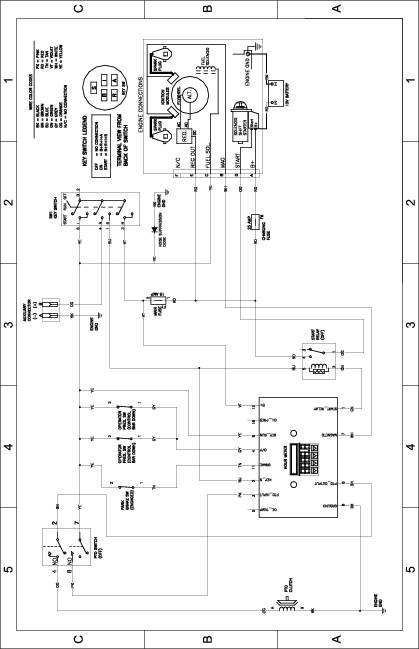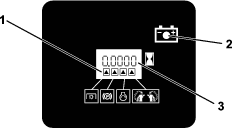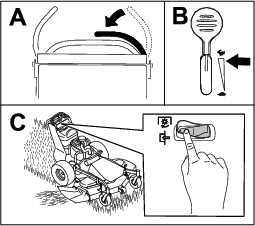| Maintenance Service Interval | Maintenance Procedure |
|---|---|
| Before each use or daily |
|
Introduction
This rotary-blade lawn mower is intended to be used by professional, hired operators. It is designed primarily for cutting grass on well-maintained lawns on residential or commercial properties. Using this product for purposes other than its intended use could prove dangerous to you and bystanders.
Read this information carefully to learn how to operate and maintain your product properly and to avoid injury and product damage. You are responsible for operating the product properly and safely.
Visit www.Toro.com for more information, including safety tips, training materials, accessory information, help finding a dealer, or to register your product.
Whenever you need service, genuine Toro parts, or additional information, contact an Authorized Service Dealer or Toro Customer Service and have the model and serial numbers of your product ready. Figure 1 identifies the location of the model and serial numbers on the product. Write the numbers in the space provided.
Important: With your mobile device, you can scan the QR code on the serial number decal (if equipped) to access warranty, parts, and other product information.
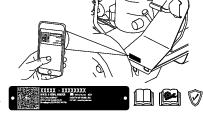
This manual identifies potential hazards and has safety messages identified by the safety-alert symbol (Figure 2), which signals a hazard that may cause serious injury or death if you do not follow the recommended precautions.

This manual uses 2 words to highlight information. Important calls attention to special mechanical information and Note emphasizes general information worthy of special attention.
It is a violation of California Public Resource Code Section 4442 or 4443 to use or operate the engine on any forest-covered, brush-covered, or grass-covered land unless the engine is equipped with a spark arrester, as defined in Section 4442, maintained in effective working order or the engine is constructed, equipped, and maintained for the prevention of fire.
The enclosed engine owner's manual is supplied for information regarding the US Environmental Protection Agency (EPA) and the California Emission Control Regulation of emission systems, maintenance, and warranty. Replacements may be ordered through the engine manufacturer.
Please refer to the engine manufacturer’s information included with the machine.
Warning
CALIFORNIA
Proposition 65 Warning
The engine exhaust from this product contains chemicals known to the State of California to cause cancer, birth defects, or other reproductive harm.
Battery posts, terminals, and related accessories contain lead and lead compounds, chemicals known to the State of California to cause cancer and reproductive harm. Wash hands after handling.
Use of this product may cause exposure to chemicals known to the State of California to cause cancer, birth defects, or other reproductive harm.
Safety
This machine has been designed in accordance with ANSI B71.4-2017.
General Safety
This product is capable of amputating hands and feet and of throwing objects. Always follow all safety instructions to avoid serious personal injury.
-
Read, understand, and follow the instructions and warnings in this Operator’s Manual and on the machine and attachments before starting the engine.
-
Do not put your hands or feet near moving parts of or under the machine. Keep clear of any discharge opening.
-
Do not operate the machine without all guards and other safety protective devices in place and functioning properly on the machine.
-
Keep bystanders and children out of the operating area. Do not allow children to operate the machine. Allow only people who are responsible, trained, familiar with the instructions, and physically capable to operate the machine.
-
Stop the machine, shut off the engine, remove the ignition key (if equipped), and wait for all moving parts to stop before servicing, fueling, or unclogging the machine.
Improperly using or maintaining this machine can result in injury.
To reduce the potential for injury, comply with these safety instructions
and always pay attention to the safety-alert symbol  , which means
Caution, Warning, or Danger—personal safety instruction. Failure
to comply with these instructions may result in personal injury or
death.
, which means
Caution, Warning, or Danger—personal safety instruction. Failure
to comply with these instructions may result in personal injury or
death.
Safety and Instructional Decals
 |
Safety decals and instructions are easily visible to the operator and are located near any area of potential danger. Replace any decal that is damaged or missing. |




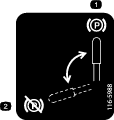
Decal 117-1194 is for 122cm (48-inch), 137cm (54-inch), and 152cm (60-inch) models only.
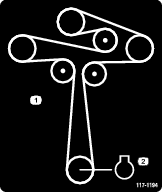


Decal 130-0765 is for 122cm (48-inch), 137cm (54-inch), and 152cm (60-inch) models only.
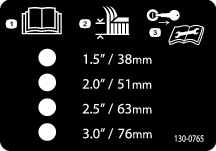
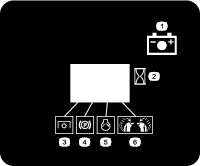
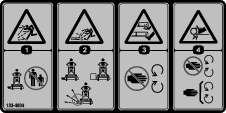


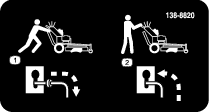


Decal 139-7936 is for 91cm (36-inch) models only.
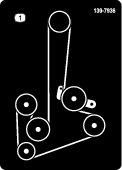

Product Overview
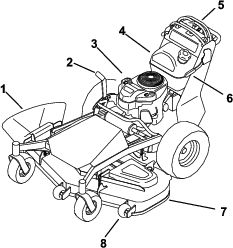
Control Panel
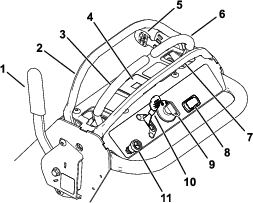
Throttle Control
The throttle controls the engine speed, and it has a continuous-variable setting from the SLOW to FAST position (Figure 4).
Blade-Control Switch (Power Takeoff)
The blade-control switch, represented by a power-takeoff (PTO) symbol, engages and disengages power to the mower blades (Figure 4).
Fuel-Shutoff Valve
Close the fuel-shutoff valve when transporting or storing the machine.
Key Switch
The key switch, used to start and shut off the engine, has 3 positions: OFF, RUN, and START.
Choke
Use the choke to start a cold engine.
Hour Meter
The hour meter records the number of hours the engine has operated. It operates when the engine is running. Use these times for scheduling regular maintenance (Figure 4).
Safety-Interlock Indicators
There are symbols on the hour meter that indicate with a black triangle that the interlock component is positioned correctly (Figure 5).
Battery-Indicator Light
Motion-Control Levers
Use the motion-control levers to drive the machine forward, reverse, and turn either direction (Figure 4).
Reference Bar Adjustment Lever
Use the adjustment lever to change the position of the adjustable reference bar (Figure 4).
Specifications and design are subject to change without notice.
| 91cm (36-inch) Mower Deck | 122 cm (48-inch) Mower Deck | 137 cm (54-inch) Mower Deck | 152 cm (60-inch) Mower Deck | |
| Cutting width | 91 cm (36 inches) | 122 cm (48 inches) | 137 cm (54 inches) | 152 cm (60 inches) |
| Width with deflector down | 130 cm (51 inches) | 160 cm (63 inches) | 175 cm (69 inches) | 191 cm (75 inches) |
| Width with deflector up | 94 cm (37 inches) | 124 cm (49 inches) | 140 cm (55 inches) | 155 cm (61 inches) |
| Height | 114 cm (45 inches) | 117 cm (46 inches) | 117 cm (46 inches) | 117 cm (46 inches) |
| Length | 196 cm (77 inches) | 203 cm (80 inches) | 203 cm (80 inches) | 211 cm (83 inches) |
| Weight | |
| 44409 | 265 kg (585 lb) |
| 44410 | 263 kg (580 lb) |
| 44423 | 292 kg (644 lb) |
| 44424 | 290 kg (639 lb) |
| 44427 | 294 kg (648 lb) |
| 44430 | 314 kg (693 lb) |
| 44448 | 303 kg (669 lb) |
| 44454 | 315 kg (695 lb) |
Attachments/Accessories
A selection of Toro approved attachments and accessories is available for use with the machine to enhance and expand its capabilities. Contact your Authorized Service Dealer or authorized Toro distributor or go to www.Toro.com for a list of all approved attachments and accessories.
To ensure optimum performance and continued safety certification of the machine, use only genuine Toro replacement parts and accessories. Replacement parts and accessories made by other manufacturers could be dangerous, and such use could void the product warranty.
Operation
Note: Determine the left and right sides of the machine from the normal operating position.
Before Operation
Before Operation Safety
General Safety
-
Do not allow children or untrained people to operate or service the machine. Local regulations may restrict the age of the operator. The owner is responsible for training all operators and mechanics.
-
Become familiar with the safe operation of the equipment, operator controls, and safety signs.
-
Always shut off the machine, remove the ignition key (if equipped), wait for all moving parts to stop, and allow the machine to cool before adjusting, servicing, cleaning, or storing it.
-
Know how to stop the machine and shut off the engine quickly.
-
Check that operator-presence controls, safety switches, and safety protective devices are attached and functioning properly. Do not operate the machine unless they are functioning properly.
-
Inspect the area where you will use the machine, and remove all objects that could interfere with the operation of the machine or that the machine could throw.
-
Evaluate the terrain to determine what accessories and attachments are needed to properly and safely perform the job.
-
Before using, always visually inspect to see that the blades, blade bolts and mower deck are not worn or damaged. Replace worn or damaged blades and bolts in sets to preserve balance.
Fuel Safety
-
Use extreme care in handling fuel. It is flammable and its vapors are explosive.
-
Extinguish all cigarettes, cigars, pipes, and other sources of ignition.
-
Use only an approved fuel container.
-
Do not remove the fuel cap or add fuel to the tank while the engine is running or hot.
-
Do not add or drain fuel in an enclosed space.
-
Do not store the machine or fuel container where there is an open flame, spark, or pilot light, such as on a water heater or other appliance.
-
If you spill fuel, do not attempt to start the engine; avoid creating a source of ignition until the fuel vapors have dissipated.
-
Do not fill containers inside a vehicle or on a truck or trailer bed with a plastic liner. Always place containers on the ground, away from the vehicle before filling.
-
Remove equipment from the truck or trailer and refuel it on the ground. If this is not possible, refuel such equipment with a portable container rather than from a fuel-dispenser nozzle.
-
Keep the nozzle in contact with the rim of the fuel tank or container operating at all times until fueling is complete.
Adding Fuel
Recommended Fuel
-
For best results, use only clean, fresh (less than 30 days old), unleaded gasoline with an octane rating of 87 or higher ((R+M)/2 rating method).
-
Ethanol: Gasoline with up to 10% ethanol (gasohol) or 15% MTBE (methyl tertiary butyl ether) by volume is acceptable. Ethanol and MTBE are not the same. Gasoline with 15% ethanol (E15) by volume is not approved for use. Never use gasoline that contains more than 10% ethanol by volume, such as E15 (contains 15% ethanol), E20 (contains 20% ethanol), or E85 (contains up to 85% ethanol). Using unapproved gasoline may cause performance problems and/or engine damage which may not be covered under warranty.
-
Do not use gasoline containing methanol.
-
Do not store fuel either in the fuel tank or fuel containers over the winter unless you use a fuel stabilizer.
-
Do not add oil to gasoline.
Using Stabilizer/Conditioner
Use a fuel stabilizer/conditioner in the machine to provide the following benefits:
-
Keeps fuel fresh longer when used as directed by the fuel-stabilizer manufacturer
-
Cleans the engine while it runs
-
Eliminates gum-like varnish buildup in the fuel system, which causes hard starting
Important: Do not use fuel additives containing methanol or ethanol.
Add the correct amount of fuel stabilizer/conditioner to the fuel.
Note: A fuel stabilizer/conditioner is most effective when mixed with fresh fuel. To minimize the chance of varnish deposits in the fuel system, use fuel stabilizer at all times.
Filling the Fuel Tank

Using the Safety-Interlock System
Warning
If the safety-interlock switches are disconnected or damaged, the machine could operate unexpectedly, causing personal injury.
-
Do not tamper with the interlock switches.
-
Check the operation of the interlock switches daily and replace any damaged switches before operating the machine.
Understanding the Safety-Interlock System
The safety-interlock system is designed to prevent PTO from engaging unless you do the following:
-
Move either motion-control lever to the center, unlocked position.
-
Pull the PTO switch to the ON position.
The safety-interlock system is designed to stop the blades/attachment if you move or release both motion-control levers outward.
The hour meter has symbols to notify the user when each interlock component is in the correct position. When the component is in the correct position, a triangle lights up in the corresponding square (Figure 7).
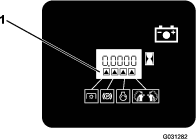
Testing the Safety-Interlock System
Test the safety-interlock system before you use the machine each time.
Note: If the safety system does not operate as described below, have an Authorized Service Dealer repair the safety system immediately.
-
Engage the parking brake and start the engine.
-
Move the motion-control levers to the center, unlocked position.
Note: The engine should shut off.
-
Start the engine and disengage the parking brake. Do not move the motion-control levers.
Note: The engine should idle 5 seconds and then shut off.
-
Engage the parking brake and start the engine.
-
Press the ON position for the PTO switch.
Note: The mower blades should not engage.
-
Disengage the parking brake.
-
Hold either motion-control lever in the center position and press the ON position for the PTO switch.
Note: The mower blades should engage.
-
Release the motion-control lever.
Note: The engine should idle 5 seconds and then shut off.
-
Engage the parking brake and start the engine.
-
Disengage the parking brake.
-
Hold either motion-control lever to the center position and press the ON position for the PTO switch.
Note: The mower blades should engage.
-
Press the OFF position for the PTO switch.
Note: The mower blades should disengage.
-
Press the ON position for the PTO switch.
Note: The mower blades should engage.
-
Engage the parking brake.
Note: The mower blades should disengage and the engine should shut off.
-
Press the ON position for the PTO switch.
-
Try starting the engine.
Note: The engine should not crank.
Performing Daily Maintenance
Before starting the machine each day, perform the Each Use/Daily procedures listed in .
During Operation
During Operation Safety
General Safety
-
The owner/operator can prevent and is responsible for accidents that may cause personal injury or property damage.
-
Wear appropriate clothing, including eye protection; long pants; substantial, slip-resistant footwear; and hearing protection. Tie back long hair and do not wear loose clothing or loose jewelry.
-
Use your full attention while operating the machine. Do not engage in any activity that causes distractions; otherwise, injury or property damage may occur.
-
Do not operate the machine while ill, tired, or under the influence of alcohol or drugs.
-
Before you start the engine, ensure that all drives are in neutral, the parking brake is engaged, and you are in the operating position.
-
Keep bystanders out of the operating area. Stop the machine if anyone enters the area.
-
Operate the machine only in good visibility and appropriate weather conditions. Do not operate the machine when there is the risk of lightning.
-
Wet grass or leaves can cause serious injury if you slip and contact the blade. Avoid mowing in wet conditions.
-
Keep your hands and feet away from the cutting unit.
-
Look behind and down before backing up to be sure of a clear path.
-
Use extreme care when approaching blind corners, shrubs, trees, or other objects that may block your view.
-
Disengage the drive to the cutting unit and engage the parking brake before adjusting the height of cut.
-
Operate the engine only in well-ventilated areas. Exhaust gases contain carbon monoxide, which is lethal if inhaled.
-
Do not leave a running machine unattended.
-
Before leaving the operating position (including to empty the catchers or to unclog the cutting units), do the following:
-
Park the machine on level ground.
-
Disengage the cutting unit and lower the attachments.
-
Engage the parking brake.
-
Shut off the machine and remove the ignition key (if equipped).
-
Wait for all moving parts to stop.
-
Shut off the machine and disengage the drive to the cutting unit in the following situations:
-
Before fueling
-
Before clearing blockages
-
Before checking, cleaning, or maintaining the cutting unit
-
After striking a foreign object or if an abnormal vibration occurs. Inspect the cutting unit for damage and make repairs before starting and operating the machine
-
Before leaving the operating position
-
-
Use only accessories and attachments approved by The Toro® Company.
-
Be sure of your footing while using this machine, especially when backing up. Walk; do not run.
-
Never operate with the discharge deflector raised, removed or altered, unless you are using a grass catcher.
-
Never carry passengers on the machine.
-
Do not direct the discharge material toward anyone. Avoid discharging material against a wall or obstruction; material may ricochet toward you. Stop the blade(s) when crossing gravel surfaces.
-
Start the engine carefully according to instructions and with your feet well away from the blade(s) and not in front of the discharge chute.
-
Use extreme caution when reversing or pulling the machine toward you.
-
Stop the blade if you must transport the machine to and from the mowing area and when crossing surfaces other than grass.
-
Slope Safety
-
Slopes are a major factor related to loss of control and rollover accidents, which can result in severe injury or death. You are responsible for safe slope operation. Operating the machine on any slope requires extra caution. Before using the machine on a slope, do the following:
-
Review and understand the slope instructions in the manual and on the machine.
-
Evaluate the site conditions of the day to determine if the slope is safe for machine operation. Use common sense and good judgment when performing this evaluation. Changes in the terrain, such as moisture, can quickly affect the operation of the machine on a slope.
-
-
Operate across slopes, never up and down. Avoid operation on excessively steep or wet slopes. Poor footing could cause a slip-and-fall accident.
-
Identify hazards at the base of the slope. Do not operate the machine near drop-offs, ditches, embankments, water, or other hazards. The machine could suddenly roll over if a wheel goes over the edge or the edge collapses. Keep a safe distance between the machine and any hazard. Use a handheld tool to operate in these areas.
-
Avoid starting, stopping, or turning the machine on slopes. Avoid making sudden changes in speed or direction; turn slowly and gradually.
-
Do not operate a machine under any conditions where traction, steering or stability is in question. Be aware that operating the machine on wet grass, across slopes or downhill may cause the machine to lose traction. Loss of traction to the drive wheels may result in sliding and a loss of braking and steering. The machine can slide even if the drive wheels are stopped.
-
Remove or mark obstacles such as ditches, holes, ruts, bumps, rocks, or other hidden hazards. Tall grass can hide obstacles. Uneven terrain could overturn the machine.
-
If you lose control of the machine, step away from the direction of travel of the machine.
-
Always keep the machine in gear when going down slopes. Do not coast downhill (applicable only to gear-drive units).
Operating the Parking Brake
Always engage the parking brake when you shut off the machine or leave the operator position. Before each use, check the parking brake for proper operation.
Pull the parking-brake lever rearward to engage it (Figure 8).
Push the parking-brake lever forward to disengage it.
Note: The engine shuts off if you move the motion-control levers while the parking brake is engaged or if the machine idles for 5 seconds while the parking brake is disengaged.

Starting the Engine
Note: If you release the motion-control levers and do not engage the parking brake, the engine will shut off after 5 seconds.
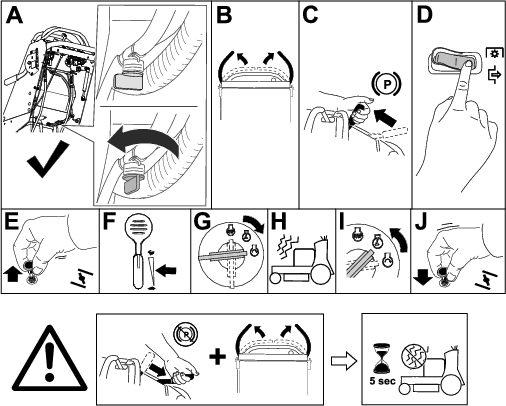
Shutting Off the Engine

Operating the Mower-Blade-Control Switch (PTO)
Driving the Machine
The throttle control regulates the engine speed as measured in rpm (revolutions per minute). Place the throttle control in the FAST position for best performance.
Note: The engine shuts off if you move the motion-control levers while the parking brake is engaged or if the machine idles for 5 seconds while the parking brake is disengaged.
Caution
The machine can spin very rapidly, and you may lose control of the machine, causing personal injury to you and damage to the machine.
Slow down the machine before making sharp turns.
Driving Forward
-
Disengage the parking brake; refer to Operating the Parking Brake.
-
Move the motion-control levers down to the NEUTRAL position.
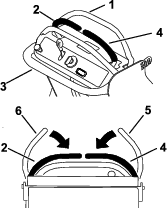
-
Slowly push the motion-control levers forward (Figure 15).
Note: The farther you move the motion-control levers in either direction, the faster the machine moves in that direction.
Note: To stop, move the motion-control levers back to the NEUTRAL position.
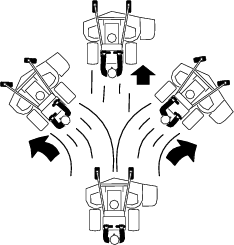
Driving Backward
-
Move both motion-control levers to the NEUTRAL position.
-
Slowly pull the motion-control levers rearward (Figure 16).

Using the Adjustable Reference Bar
Use the adjustment lever to change the position of the adjustable reference bar and limit the maximum forward speed (Figure 17).
Move the lever to the upper position to decrease the maximum speed; move the lever to the lower position to increase the maximum speed.

Side Discharging or Mulching Grass
This mower has a hinged grass deflector that disperses clippings to the side and down toward the turf.
Danger
Without the grass deflector, discharge cover, or complete grass catcher assembly mounted in place, you and bystanders are exposed to blade contact and thrown debris. Contact with rotating mower blade(s) and thrown debris can cause serious injury or death.
-
Never remove the grass deflector from the mower deck, because the grass deflector routes material down toward the turf. If the grass deflector is damaged, replace it immediately.
-
Never put your hands or feet under the mower deck.
-
Never try to clear the discharge area or mower blades before you disengage the mower blades. Turn the ignition key to the OFF position. Remove the key and disconnect the spark-plug wires.
Adjusting the Height of Cut
You can adjust the height of cut from 38 to 114 mm (1-1/2 to 4-1/2 inches) in 6 mm (1/4 inch) increments.
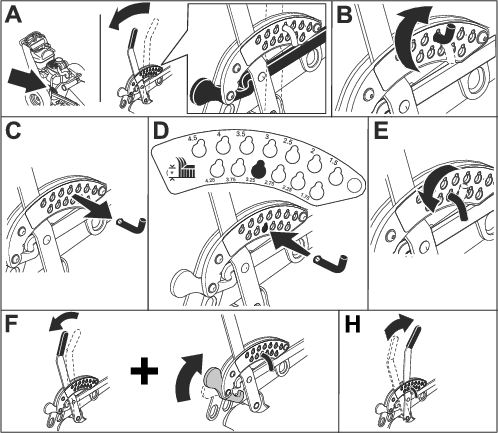
Adjusting the Anti-Scalp Rollers
Whenever you change the height-of-cut, adjust the height of the anti-scalp rollers.
-
Park the machine on a level surface, disengage the blade-control switch, and engage the parking brake.
-
Shut off the engine, remove the key, and wait for all moving parts to stop before leaving the operating position.
-
Remove the nut and bolt position the anti-scalp rollers and install the nut and bolt.
-
Ensure that the spacers and bushings are installed (Figure 19).
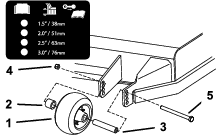
After Operation
After Operation Safety
General Safety
-
Always shut off the machine, remove the ignition key (if equipped), wait for all moving parts to stop, and allow the machine to cool before adjusting, servicing, cleaning, or storing it.
-
Clean grass and debris from the machine to help prevent fires. Clean up oil or fuel spills.
-
Never store the machine or fuel container where there is an open flame, spark, or pilot light, such as on a water heater or on other appliances.
-
Use full-width ramps for loading the machine into a trailer or truck.
-
Tie the machine down securely using straps, chains, cable, or ropes. Direct both front and rear straps down and outward from the machine.
Using the Fuel-Shutoff Valve
Close the fuel-shutoff valve for transport, maintenance, and storage (Figure 20).
Ensure that the fuel-shutoff valve is open when starting the engine.
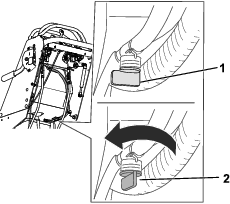
Pushing the Machine by Hand
Important: Always push the machine by hand. Do not tow the machine, because towing may damage it.
Important: Do not start or operate the machine with the bypass valves open. Damage to system may occur.
Pushing the Machine
-
Park the machine on a level surface, disengage the blade-control switch, and engage the parking brake.
-
Shut off the engine, remove the key, and wait for all moving parts to stop before leaving the operating position.
-
Locate the bypass levers on the frame on both sides of the engine.
-
Move the bypass levers rearward through the key hole and down to lock them in place (Figure 21).
Note: Do this for each lever.
-
Disengage the parking brake.
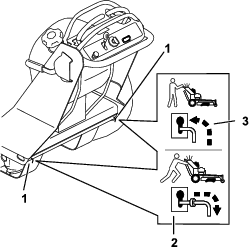
-
When finished, engage the parking brake.
Operating the Machine
Move the bypass levers forward through the keyhole and down to lock them in place as shown in Figure 21.
Note: Do this for each lever.
Transporting the Machine
Use a heavy-duty trailer or truck to transport the machine. Use a full-width ramp. Ensure that the trailer or truck has all the necessary brakes, lighting, and marking as required by law. Please carefully read all the safety instructions. Knowing this information could help you or bystanders avoid injury. Refer to your local ordinances for trailer and tie-down requirements.
Warning
Driving on the street or roadway without turn signals, lights, reflective markings, or a slow-moving-vehicle emblem is dangerous and can lead to accidents, causing personal injury.
Do not drive the machine on a public street or roadway.
Selecting a Trailer
Warning
Loading a machine onto a trailer or truck increases the possibility of tip-over and could cause serious injury or death (Figure 22).
-
Use only a full-width ramp; do not use individual ramps for each side of the machine.
-
Ensure that the length of ramp is at least 4 times as long as the height of the trailer or truck bed to the ground.

Loading the Machine
Warning
Loading a machine onto a trailer or truck increases the possibility of tip-over and could cause serious injury or death.
-
Use extreme caution when operating a machine on a ramp.
-
Back the machine up the ramp and walk it forward down the ramp.
-
Avoid sudden acceleration or deceleration while driving the machine on a ramp as this could cause a loss of control or a tip-over situation.
-
If using a trailer, connect it to the towing vehicle and connect the safety chains.
-
If applicable, connect the trailer brakes and lights.
-
Lower the ramp (Figure 22).
-
Back the machine up the ramp (Figure 23).

-
Shut off the engine, remove the key, and engage the parking brake.
-
Tie down the machine near the front caster wheels and the rear bumper with straps, chains, cable, or ropes (Figure 24). Refer to local regulations for tie-down requirements.
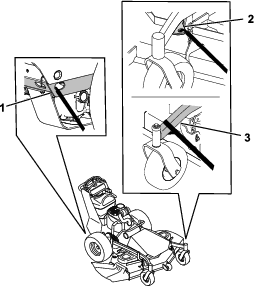
Maintenance
Note: Determine the left and right sides of the machine from the normal operating position.
Maintenance Safety
-
Before adjusting, cleaning, servicing, or leaving the machine, do the following:
-
Park the machine on a level surface.
-
Move the throttle switch to the low-idle position.
-
Disengage the cutting units.
-
Ensure that the transmission is in neutral.
-
Engage the parking brake.
-
Shut off the engine and remove the key.
-
Wait for all moving parts to stop.
-
Allow machine components to cool before performing maintenance.
-
-
Do not allow untrained personnel to service the machine.
-
If the engine must be running to perform a maintenance adjustment, keep your hands, feet, clothing, and any parts of the body away from the cutting unit, attachments, and any moving parts. Keep bystanders away.
-
Keep all parts in good working condition. Replace all worn, damaged, or missing parts and decals. Keep all fasteners tight to ensure that the machine is in safe working condition.
-
Check the grass catcher components frequently and replace them when they are worn or damaged.
-
Clean grass and debris from the cutting unit, drives, muffler, cooling screen, and the engine to help prevent fires. Clean up oil or fuel spills.
-
Check the brake operation frequently. Adjust and service the brake as needed.
-
Carefully release pressure from components with stored energy.
-
To ensure safe, optimal performance of the machine, use only genuine Toro replacement parts. Replacement parts made by other manufacturers could be dangerous, and such use could void the product warranty.
Recommended Maintenance Schedule(s)
| Maintenance Service Interval | Maintenance Procedure |
|---|---|
| After the first 8 hours |
|
| After the first 50 hours |
|
| After the first 100 hours |
|
| Before each use or daily |
|
| Every 25 hours |
|
| Every 50 hours |
|
| Every 100 hours |
|
| Every 200 hours |
|
| Every 250 hours |
|
| Every 300 hours |
|
| Every 500 hours |
|
| Every 800 hours |
|
| Yearly |
|
Important: Refer to your engine owner's manual for additional maintenance procedures.
Caution
If you leave the key in the switch, someone could accidently start the engine and seriously injure you or other bystanders.
Shut off the engine and remove the key from the switch before you perform any maintenance.
Pre-Maintenance Procedures
Removing the Mower Deck Guard
-
Park the machine on a level surface, disengage the blade-control switch (PTO), and engage the parking brake.
-
Shut off the engine, remove the key, and wait for all moving parts to stop before leaving the operating position.
-
Unlatch the 2 rubber latches from the screws and remove the deck cover (Figure 25).
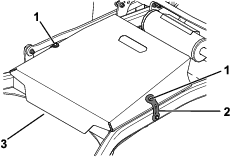
Lubrication
Greasing the Machine
Grease the machine more often in dirty or dusty conditions.
Grease Type: No. 2 lithium or molybdenum grease
-
Park the machine on a level surface, disengage the blade-control switch (PTO), and engage the parking brake.
-
Shut off the engine, remove the key, and wait for all moving parts to stop before leaving the operating position.
-
Clean the grease fittings with a rag.
Note: Scrape any paint off the front of the fitting(s).
-
Pump grease into the fittings until grease begins to ooze out of the bearings.
-
Wipe up any excess grease.
Greasing the Front Caster Pivots
| Maintenance Service Interval | Maintenance Procedure |
|---|---|
| Yearly |
|
Grease type: Lithium or molybdenum grease
-
Remove the dust cap and adjust the caster pivots; refer to Adjusting the Caster-Pivot Bearings.
Note: Keep the dust cap off until you have finished greasing the caster pivots.
-
Remove the hex plug.
-
Thread a grease fitting into the hole.
-
Pump grease into the fitting until it oozes out around the top bearing.
-
Remove the grease fitting from the hole.
-
Install the hex plug and dust cap.
Greasing the Caster Wheel Bearings
| Maintenance Service Interval | Maintenance Procedure |
|---|---|
| Every 25 hours |
|
Grease Type: No. 2 lithium grease
-
Park the machine on a level surface, disengage the blade-control switch, and engage the parking brake.
-
Shut off the engine, remove the key, and wait for all moving parts to stop before leaving the operating position.
-
Clean the grease fittings (Figure 26) with a rag.
Note: Scrape any paint off the front of the fitting(s).

-
Connect a grease gun to each fitting (Figure 26).
-
Pump grease into the fittings until grease begins to ooze out of the bearings.
-
Wipe up any excess grease.
Engine Maintenance
Engine Safety
-
Do not change the governor speed or overspeed the engine.
-
Run the engine dry or remove the fuel with a hand pump; never siphon the fuel. If you must drain the fuel tank, do it outdoors.
Servicing the Air Cleaner
| Maintenance Service Interval | Maintenance Procedure |
|---|---|
| Every 300 hours |
|
Refer to Figure 27 to identify the air cleaner for your engine.
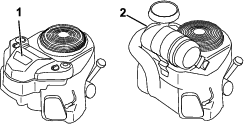
Servicing a Standard Air Cleaner
| Maintenance Service Interval | Maintenance Procedure |
|---|---|
| Every 25 hours |
|
| Every 50 hours |
|
| Every 200 hours |
|
Note: Service the air cleaner more frequently (every few operating hours) if the operating conditions are extremely dusty or sandy.
Important: Do not apply oil to the foam or paper element.
Removing the Foam and Paper Elements
-
Park the machine on a level surface, disengage the PTO, and engage the parking brake.
-
Shut off the engine, remove the key, and wait for all moving parts to stop before leaving the operating position.
-
Clean the area around the air cleaner to prevent dirt from entering the engine and causing damage (Figure 28).
-
Unscrew the cover knobs and remove the air-cleaner cover (Figure 28).
-
Unscrew the hose clamp and remove the air-cleaner assembly (Figure 28).
-
Carefully pull the foam element off the paper element (Figure 28).
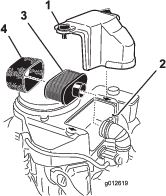
Cleaning the Foam Air-Cleaner Element
-
Wash the foam element in liquid soap and warm water. When the element is clean, rinse it thoroughly.
-
Dry the element by squeezing it in a clean cloth.
Important: Replace the foam element if it is torn or worn.
Servicing the Paper Air-Cleaner Element
Important: Do not clean the paper filter, replace it (Figure 28).
-
Inspect the element for tears, an oily film, or damage to the rubber seal.
-
Replace the paper element if it is damaged.
Installing the Foam and Paper Elements
Important: To prevent engine damage, always operate the engine with the complete foam and paper air-cleaner assembly installed.
Servicing a Heavy Duty Air Cleaner
| Maintenance Service Interval | Maintenance Procedure |
|---|---|
| Every 250 hours |
|
| Every 500 hours |
|
Note: Service the air cleaner more frequently if operating conditions are extremely dusty or sandy.
Removing the Filters
-
Park the machine on a level surface, disengage the blade-control switch (PTO), and engage the parking brake.
-
Shut off the engine, remove the key, and wait for all moving parts to stop before leaving the operating position.
-
Release the latches on the air cleaner and pull the air-cleaner cover off the air-cleaner body (Figure 29).
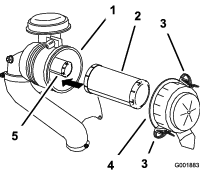
-
Clean the inside of the air-cleaner cover with compressed air.
-
Gently slide the primary filter out of the air-cleaner body (Figure 29).
Note: Avoid knocking the filter into the side of the body.
-
Remove the safety filter only to replace it.
Inspecting the Filters
-
Inspect the safety filter. If it is dirty, replace both the safety and primary filters.
Important: Do not attempt to clean the safety filter. If the safety filter is dirty, then the primary filter is damaged.
-
Inspect the primary filter for damage by looking into the filter while shining a bright light on the outside of the filter. If the primary filter is dirty, bent, or damaged, replace it.
Note: Holes in the filter appear as bright spots. Do not clean the primary filter.
Installing the Filters
Important: To prevent engine damage, always operate the engine with both air filters and the cover installed.
-
If you are installing new filters, check each filter for shipping damage.
Note: Do not use a damaged filter.
-
If you are replacing the inner filter, carefully slide it into the filter body (Figure 29).
-
Carefully slide the primary filter over the safety filter (Figure 29).
Note: Ensure that the primary filter is fully seated by pushing on the outer rim while installing it.
Important: Do not press on the soft, inside area of the filter.
-
Install the air-cleaner cover and secure the latches (Figure 29).
Servicing the Engine Oil
Engine-Oil Specifications
Model 44409, 44410, 44423, 44424, and 44427
Oil Type: Detergent oil (API service SF, SG, SH, SJ, or SL)
Engine Oil Capacity: 1.5 L (51 fl oz) without filter; 1.7 L (57 fl oz) with filter
Viscosity: Refer to the table below.
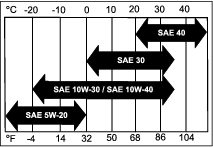
Model 44430, 44448, and 44454
Oil Type: Detergent oil (API service SF, SG, SH, SJ, or SL)
Engine Oil Capacity: 1.8 L (61 fl oz) without filter; 2.0 L (68 fl oz) with filter
Viscosity: Refer to the table below.
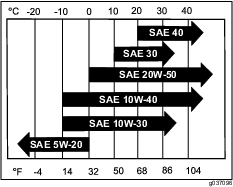
Checking the Engine-Oil Level
| Maintenance Service Interval | Maintenance Procedure |
|---|---|
| Before each use or daily |
|
Note: Check the oil when the engine is cold.
Warning
Contact with hot surfaces may cause personal injury.
Keep your hands, feet, face, clothing and other body parts away the muffler and other hot surfaces.
Important: Do not overfill the crankcase with oil because damage to the engine may result. Do not run engine with oil below the low mark because the engine may be damaged.
-
Park the machine on a level surface, disengage the PTO, and engage the parking brake.
-
Shut off the engine, remove the key, and wait for all moving parts to stop before leaving the operating position.
-
Check the engine-oil level as shown in (Figure 32).
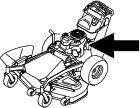

Changing the Engine Oil
| Maintenance Service Interval | Maintenance Procedure |
|---|---|
| After the first 8 hours |
|
| Every 100 hours |
|
Note: Dispose of the used oil at a recycling center.
-
Park the machine so that the drain side is slightly lower than the opposite side to assure the oil drains completely.
-
Disengage the PTO and engage the parking brake.
-
Shut off the engine, remove the key, and wait for all moving parts to stop before leaving the operating position.
-
Change the engine oil as shown in Figure 33.
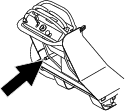
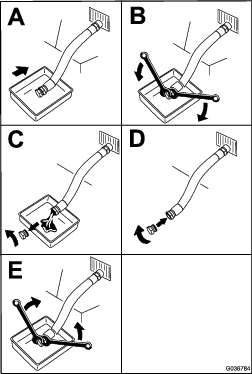
-
Slowly pour approximately 80% of the specified oil into the filler tube and slowly add the additional oil to bring it to the Full mark (Figure 34).
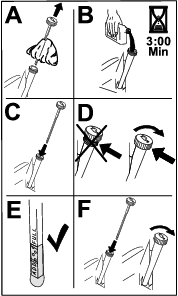
-
Start the engine and drive to a flat area.
-
Check the oil level again.
Changing the Engine-Oil Filter
| Maintenance Service Interval | Maintenance Procedure |
|---|---|
| Every 200 hours |
|
Note: Change the engine-oil filter more frequently when operating conditions are extremely dusty or sandy.
-
Drain the oil from the engine; refer to Changing the Engine Oil.
-
Change the engine-oil filter (Figure 35).

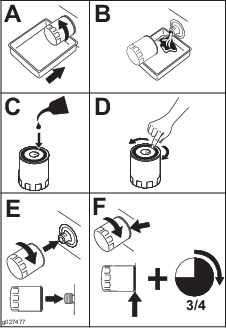
Note: Ensure that the oil-filter gasket touches the engine, then rotate the filter an extra 3/4 turn.
-
Fill the crankcase with the proper type of new oil; refer to Engine-Oil Specifications.
Servicing the Spark Plug
| Maintenance Service Interval | Maintenance Procedure |
|---|---|
| Every 100 hours |
|
Ensure that the air gap between the center and side electrodes is correct before installing the spark plug.
Use a spark plug wrench for removing and installing the spark plug(s) and a gapping tool/feeler gauge to check and adjust the air gap. Install a new spark plug(s) if necessary.
Type: NGK® BPR4ES or equivalent
Air gap: 0.75 mm (0.03 inch)
Removing the Spark Plug
-
Park the machine on a level surface, disengage the PTO, and engage the parking brake.
-
Shut off the engine, remove the key, and wait for all moving parts to stop before leaving the operating position.
-
Remove the spark plug as shown in Figure 36.
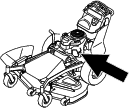
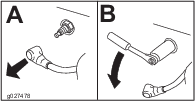
Checking the Spark Plug
Important: Do not clean the spark plug(s). Always replace the spark plug(s) when it has a black coating, worn electrodes, an oily film, or cracks.
If you see light brown or gray on the insulator, the engine is operating properly. A black coating on the insulator usually means the air cleaner is dirty.
Set the gap to 0.75 mm (0.03 inch).
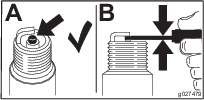
Installing the Spark Plug
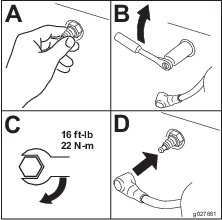
Fuel System Maintenance
Danger
In certain conditions, fuel is extremely flammable and highly explosive. A fire or explosion from fuel can burn you and others and can damage property.
Refer to Fuel Safety for a complete list of fuel related precautions.
Draining the Fuel Tank
Note: Use a syphon pump to drain fuel from the tank. You can purchase a syphon pump at a hardware store.
Danger
In certain conditions, fuel is extremely flammable and highly explosive. A fire or explosion from fuel can burn you, others, and can damage property.
-
Perform any fuel-related maintenance when the engine is cold. Do this outdoors in an open area. Wipe up any fuel that spills.
-
Never smoke when draining fuel, and stay away from an open flame or where a spark may ignite the fuel fumes.
-
Park the machine on a level surface, disengage the PTO, and engage the parking brake.
-
Shut off the engine, remove the key, and wait for all moving parts to stop before leaving the operating position.
-
Clean around the fuel cap to prevent debris from getting into the fuel tank (Figure 39).
-
Remove the fuel cap.
-
Insert a syphon pump into the fuel tank.
-
Using the syphon pump, drain the fuel into a clean fuel can (Figure 39).
-
Wipe up any spilled fuel.
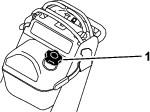
Replacing the Fuel Filter
| Maintenance Service Interval | Maintenance Procedure |
|---|---|
| Every 800 hours |
|
Do not install a dirty filter if it is removed from the fuel line.
Note: Wipe up any spilled fuel.
-
Park the machine on a level surface, disengage the PTO, and engage the parking brake.
-
Shut off the engine, remove the key, and wait for all moving parts to stop before leaving the operating position.
-
Close the fuel-shutoff valve; refer to Using the Fuel-Shutoff Valve.
-
Replace the fuel filter as shown in Figure 40.
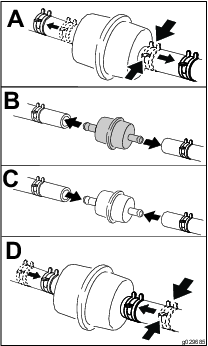
Electrical System Maintenance
Electrical System Safety
-
Disconnect the battery before repairing the machine. Disconnect the negative terminal first and the positive last. Connect the positive terminal first and the negative last.
-
Charge the battery in an open, well-ventilated area, away from sparks and flames. Unplug the charger before connecting or disconnecting the battery. Wear protective clothing and use insulated tools.
Servicing the Battery
| Maintenance Service Interval | Maintenance Procedure |
|---|---|
| Every 100 hours |
|
Always keep the battery clean and fully charged. Use a paper towel to clean the battery case. If the battery terminals are corroded, clean them with a solution of four parts water and 1 part baking soda. Apply a light coating of grease to the battery terminals to prevent corrosion.
Voltage: 12 V
Removing the Battery
-
Park the machine on a level surface, disengage the PTO, and engage the parking brake.
-
Shut off the engine, remove the key, and wait for all moving parts to stop before leaving the operating position.
-
Disconnect the negative (black) ground cable from the battery post (Figure 41).
Note: Retain all fasteners.
Warning
Battery terminals or metal tools could short against metal machine components, causing sparks. Sparks can cause the battery gasses to explode, resulting in personal injury.
-
When removing or installing the battery, do not allow the battery terminals to touch any metal parts of the machine.
-
Do not allow metal tools to short between the battery terminals and metal parts of the machine.
Warning
Incorrectly removing the cables from battery could damage the machine and cables, causing sparks. Sparks can cause the battery gasses to explode, resulting in personal injury.
-
Always disconnect the negative (black) battery cable before disconnecting the positive (red) cable.
-
Always connect the positive (red) battery cable before connecting the negative (black) cable.
-
-
Slide the rubber cover off the positive (red) cable.
-
Disconnect the positive (red) cable from the battery post (Figure 41).
Note: Retain all fasteners.
-
Remove the battery hold-down (Figure 41), and lift the battery from the tray.
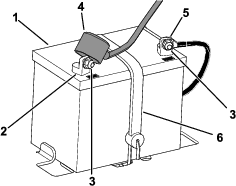
Charging the Battery
Warning
Charging the battery produces gasses that can explode.
Never smoke near the battery and keep sparks and flames away from battery.
Important: Always keep the battery fully charged (1.260 specific gravity). This is especially important to prevent battery damage when the temperature is below 0°C (32°F).
-
Remove the battery from the machine; refer to Removing the Battery.
-
Connect a 3 to 4 A battery charger to the battery posts. Charge the battery at a rate of 3 to 4 A for 4 to 8 hours (12 V).
Note: Do not overcharge the battery.
-
When the battery is fully charged, unplug the charger from the electrical outlet, and disconnect the charger leads from the battery posts (Figure 42).
-
Install the battery; refer to Installing the Battery.
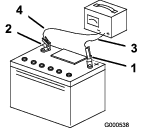
Installing the Battery
-
Position the battery in the tray (Figure 41).
-
Using the fasteners previously removed, install the positive (red) battery cable to the positive (+) battery terminal.
-
Using the fasteners previously removed, install the negative battery cable to the negative (-) battery terminal.
-
Slide the red terminal boot onto the positive (red) battery post.
-
Secure the battery with the hold-down (Figure 41).
Servicing the Fuses
The electrical system is protected by fuses. It requires no maintenance; however, if a fuse blows, check the component/circuit for a malfunction or short.
-
Park the machine on a level surface, disengage the PTO, and engage the parking brake.
-
Shut off the engine, remove the key, and wait for all moving parts to stop before leaving the operating position.
-
Pull out the fuse to remove or replace it.
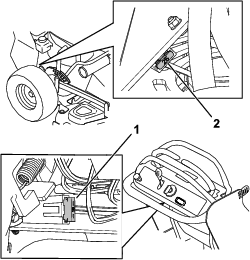
Drive System Maintenance
Checking the Tire Pressure

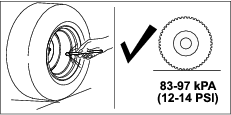
Checking the Wheel-Lug Nuts
| Maintenance Service Interval | Maintenance Procedure |
|---|---|
| After the first 100 hours |
|
Check and torque the wheel-lug nuts to 115 to 142 N∙m (85 to 105 ft-lb).
Adjusting the Neutral Traction
If the machine creeps while the motion-control levers are in neutral, adjust the neutral traction.
-
Park the machine on a level surface, disengage the PTO, and engage the parking brake.
-
Shut off the engine, remove the key, and wait for all moving parts to stop before leaving the operating position.
-
Raise the rear of the machine onto jack stands high enough to raise the drive wheels off the ground.
-
Loosen the nut for control-rod assembly (Figure 45).
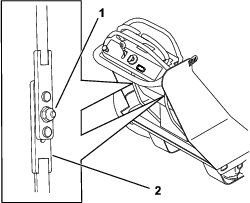
-
Start the machine and move the throttle control to the FAST position.
-
To find the neutral position, move the lower control rod up or down until the tire stops rotating (Figure 45).
-
Tighten the nut (Figure 45).
Important: Ensure that the rod does not move; otherwise, you may need to adjust the rod again.
-
Repeat for the other lever.
Note: You may need to adjust the tracking after adjusting the neutral traction; refer to Adjusting the Tracking.
Adjusting the Tracking
If you push both motion-control levers forward full speed across a flat, level surface and the machine pulls to 1 side, adjust the tracking as follows.
-
Park the machine on a level surface, disengage the PTO, and engage the parking brake.
-
Shut off the engine, remove the key, and wait for all moving parts to stop before leaving the operating position.
-
Rotate the adjustment screw shown in Figure 45 to increase or decrease the speed for that lever.
Note: Rotate the screw clockwise to decrease the speed; rotate it counterclockwise to increase the speed.If the machine pulls to the left, decrease the speed for the right lever or increase the speed for the left lever.If the machine pulls to the right, decrease the speed for the left lever or increase the speed for the right lever.
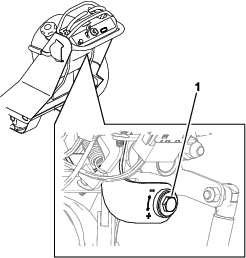
-
Start the machine and drive forward across a flat, level surface with the motion-control levers fully forward to check if the machine tracks straight. Repeat the procedure as needed.
Adjusting the Caster-Pivot Bearings
| Maintenance Service Interval | Maintenance Procedure |
|---|---|
| Every 500 hours |
|
Note: You do not need to adjust the caster-pivot bearings for 91 cm (36 inch) machines.
-
Park the machine on a level surface, disengage the blade-control switch, and engage the parking brake.
-
Shut off the engine, remove the key, and wait for all moving parts to stop before leaving the operating position.
-
Remove the dust cap from the caster and tighten the locknut (Figure 47).
-
Tighten the locknut until the spring washers are flat, and then back off a 1/4 turn to properly set the preload on the bearings (Figure 47).
Important: Make sure that the spring washers are installed correctly as shown in Figure 47.
-
Install the dust cap (Figure 47).
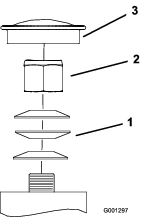
Servicing the Caster Wheels and Bearings
The caster wheels rotate on a roller bearing supported by a spanner bushing. If the bearing is kept well lubricated, wear will be minimal. Failure to keep the bearing well lubricated causes rapid wear. A wobbly caster wheel usually indicates a worn bearing.
-
Remove the locknut and wheel bolt holding the caster wheel to the caster fork (Figure 48).
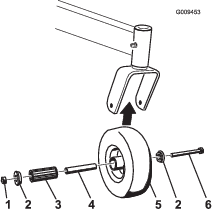
-
Remove 1 bushing, then pull the spanner bushing and roller bearing out of the wheel hub (Figure 48).
-
Remove the other bushing from the wheel hub and clean any grease and dirt from the wheel hub (Figure 48).
-
Inspect the roller bearing, bushings, spanner bushing and the inside of the wheel hub for wear.
Note: Replace any damaged or worn parts (Figure 48).
-
Place 1 bushing into the wheel hub (Figure 48).
-
Grease the roller bearing and spanner bushing, and slide them into the wheel hub (Figure 48).
-
Place the second bushing into the wheel hub (Figure 48).
-
Install the caster wheel into the caster fork and secure it with the wheel bolt and locknut (Figure 48).
-
Tighten the locknut until the spanner bushing bottoms against the inside of the caster forks (Figure 48).
-
Grease the fitting on the caster wheel.
Cooling System Maintenance
Cleaning the Air-Intake Screen
| Maintenance Service Interval | Maintenance Procedure |
|---|---|
| Before each use or daily |
|
Remove any buildup of grass, dirt, or other debris from the cylinder and cylinder head cooling fins, the air-intake screen on the flywheel end, and the carburetor-governor levers and linkage. This helps ensure adequate cooling and correct engine speed to reduce the possibility of overheating or mechanical damage to the engine.
Cleaning the Cooling System
| Maintenance Service Interval | Maintenance Procedure |
|---|---|
| Before each use or daily |
|
| Every 100 hours |
|
-
Park the machine on a level surface, disengage the PTO, and engage the parking brake.
-
Shut off the engine, remove the key, and wait for all moving parts to stop before leaving the operating position.
-
Remove the air-intake screen, recoil starter, and fan housing (Figure 49).
-
Clean the debris and grass from the engine parts.
-
Install the air-intake screen, recoil starter, and fan housing (Figure 49).
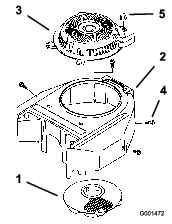
Brake Maintenance
Testing the Parking Brake
| Maintenance Service Interval | Maintenance Procedure |
|---|---|
| Before each use or daily |
|
Before each use, test the parking brake on both a level surface and slope.
Always engage the parking brake when you stop the machine or leave it unattended. If the parking brake does not hold securely, adjust it.
-
Disengage the PTO and engage the parking brake
-
Shut off the engine, remove the key, and wait for all moving parts to stop before leaving the operating position.
-
Disengage the parking brake.
-
Engage the brake lever and ensure that the machine does not move.
-
Adjust the brake if needed.
Adjusting the Parking Brake
-
Park the machine on a level surface and disengage the PTO.
-
Shut off the engine, remove the key, and wait for all moving parts to stop before leaving the operating position.
-
Release the parking brake.
-
Loosen the bolt on the cable clamp on the left side of the machine (Figure 50).
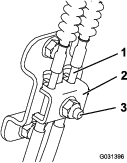
-
Pull down on the cables until they are tight.
-
Tighten the nut.
-
Check the parking brake function; refer to Testing the Parking Brake.
Belt Maintenance
Inspecting the Belts
| Maintenance Service Interval | Maintenance Procedure |
|---|---|
| Every 25 hours |
|
Replace the belt if it is worn. The signs of a worn belt include squealing while the belt is rotating; the blades slipping while cutting grass; and frayed edges, burn marks, and cracks on the belt.
Replacing the Mower-Deck Belt
Warning
The spring is under tension when installed and can cause personal injury.
Be careful when removing the belt.
-
Park the machine on a level surface, disengage the PTO, and engage the parking brake.
-
Shut off the engine, remove the key, and wait for all moving parts to stop before leaving the operating position.
-
For 91 cm (36-inch) decks, loosen the 2 bolts for both pulley covers and slide the covers off (Figure 51).

-
For 122 cm (48-inch), 137 cm (54-inch), and 152 cm (60-inch) decks, loosen the 4 screws for both pulley covers and remove the covers (Figure 52).
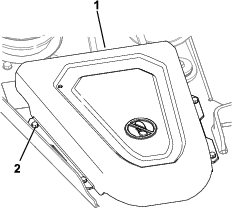
-
Using a spring-removal tool (Toro Part No. 92-5771), remove the idler spring from the deck hook to remove tension on the idler pulley, and roll the belt off the pulleys (Figure 53 or Figure 54).

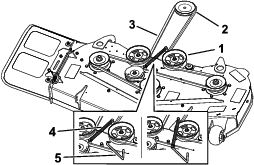
-
Route the new belt around the clutch pulley and mower pulleys (Figure 53 or Figure 54).
-
Install the idler spring to the deck hook (Figure 53 or Figure 54).
-
Check the length of the spring. If it is less than 15.2 cm (6 inches), adjust the idler pulley arm; proceed to step 4 in Adjusting the Idler Pulley Arm.
Adjusting the Idler Pulley Arm
| Maintenance Service Interval | Maintenance Procedure |
|---|---|
| Yearly |
|
If the length of the spring is less than 15.2 cm (6 inches) or if the idler pulley arm contacts the idler stop shown in Figure 55, adjust the idler pulley arm.
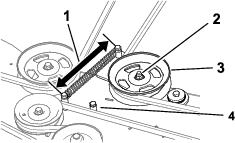
-
Park the machine on a level surface, disengage the PTO, and engage the parking brake.
-
Shut off the engine, remove the key, and wait for all moving parts to stop before leaving the operating position.
-
Remove the deck guards; refer to Removing the Mower Deck Guard
-
Loosen the nut on the idler pulley (Figure 55).
-
Adjust the pulley in the slot as needed (Figure 56).
Slide the pulley to the left of the slot for a worn belt or if the spring length is more than 15.2 cm (6 inches).
Slide the pulley to the right of the slot for a new belt or if the spring length is less than 15.2 cm (6 inches)
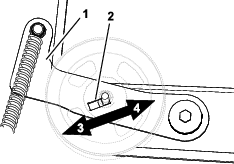
-
Tighten the nut (Figure 55).
-
Install the deck guard; refer to Removing the Mower Deck Guard.
Replacing the Transmission Belt
-
Park the machine on a level surface, disengage the PTO, and engage the parking brake.
-
Shut off the engine, remove the key, and wait for all moving parts to stop before leaving the operating position.
-
Remove the mower-deck belt from the clutch pulley; refer to Replacing the Mower-Deck Belt.
-
Remove the clutch pulley (Figure 57).
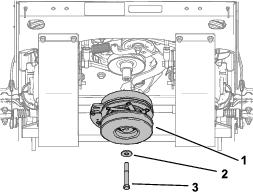
-
Insert a drive ratchet in the square hole of the idler arm to release the belt tension (Figure 58).
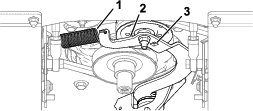
-
Remove the belt (Figure 59).
-
Slowly release the driver to release the spring tension. Remove the spring from the anchor on the frame, if needed.
-
Install the new belt, routing it around the pulleys as shown in Figure 59.
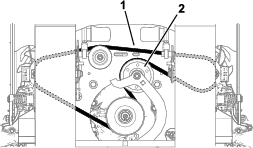
-
Install the spring to the spring anchor. Use the drive ratchet to apply tension to the spring to allow the belt to pass over the lip of the idler pulley (Figure 58).
-
Release the tension in the spring to apply tension to the belt.
-
Check that the belt is seated properly in all the pulleys.
-
Install the clutch pulley (Figure 57). Torque the bolt to 68 to 81 N∙m (50 to 60 ft-lb).
-
Install the mower-deck belt to the clutch pulley; refer to Replacing the Mower-Deck Belt.
Controls System Maintenance
Adjusting the Motion-Control Levers
If the motion-control levers do not align horizontally, adjust the motion-control levers.
-
Park the machine on a level surface, disengage the PTO, and engage the parking brake.
-
Shut off the engine, remove the key, and wait for all moving parts to stop before leaving the operating position.
-
Push the motion-control levers down to the operating position .

-
Check the horizontal alignment of the motion-control levers (Figure 60).
-
Loosen the nut holding the cam for the motion-control lever you are adjusting (Figure 61).
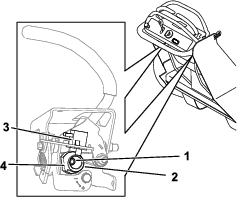
-
Adjust the cam until it aligns with the other motion-control lever and tighten the nut for the cam (Figure 61).
Note: Moving the cam clockwise lowers the lever; moving the cam counterclockwise raises the lever.
Important: Do not rotate the flat of the cam past vertical. The operator-presence control switch should never contact the flat of the cam (Figure 61).
Hydraulic System Maintenance
Hydraulic System Safety
-
Seek immediate medical attention if fluid is injected into skin. Injected fluid must be surgically removed within a few hours by a doctor.
-
Ensure that all hydraulic-fluid hoses and lines are in good condition and all hydraulic connections and fittings are tight before applying pressure to the hydraulic system.
-
Keep your body and hands away from pinhole leaks or nozzles that eject high-pressure hydraulic fluid.
-
Use cardboard or paper to find hydraulic leaks.
-
Safely relieve all pressure in the hydraulic system before performing any work on the hydraulic system.
Hydraulic System Specifications
Hydraulic Fluid Type: Toro® HYPR-OIL™ 500 hydraulic fluid
Hydraulic System Fluid Capacity: 4.7 L (159 fl oz)
Important: Use the fluid specified. Other fluids could damage the system.
Checking the Hydraulic Fluid Level
| Maintenance Service Interval | Maintenance Procedure |
|---|---|
| Every 50 hours |
|
-
Park the machine on a level surface, disengage the PTO, and engage the parking brake.
-
Shut off the engine, remove the key, and wait for all moving parts to stop before leaving the operating position.
-
All the machine to cool completely.
-
Check the fluid level on the side of the hydraulic tank (Figure 62). Continue the procedure if the level is below the cold fill level.
-
Clean the area around the cap of the hydraulic tank (Figure 62).
-
Remove the cap from the filler neck and add fluid to the reservoir until it reaches the cold fill level (Figure 62).
-
Install the cap on the tank (Figure 62).

Changing the Hydraulic Fluid and Filters
| Maintenance Service Interval | Maintenance Procedure |
|---|---|
| After the first 50 hours |
|
| Every 500 hours |
|
To replace the hydraulic fluid, the filters need to be removed. Replace both at the same time; refer to Hydraulic System Specifications for fluid specifications.
Removing the Filters and Draining the Fluid
-
Park the machine on a level surface, disengage the blade-control switch (PTO), and engage the parking brake.
-
Shut off the engine, remove the key, and wait for all moving parts to stop before leaving the operating position.
-
Allow the engine to cool.
-
Remove the 2 bolts and nuts from the transaxle guards (Figure 63).
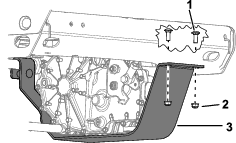
-
Pivot the guards down.
-
Locate the filter and guards on each transaxle-drive system (Figure 64).
-
Remove the 3 screws securing the filter guard and remove the guard (Figure 64).
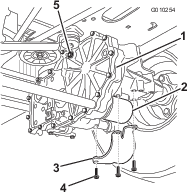
-
Carefully clean the area around the filters.
Important: Do not allow dirt to enter the hydraulic system, or contamination may occur.
-
Place a drain pan below the filter to catch the fluid that drains when the filter and vent plugs are removed.
-
Locate and remove the vent plug on each transmission
-
Unscrew the filter to remove it, and allow the fluid to drain from the drive system.
-
Repeat this procedure for both filters.
Installing the Hydraulic Filters
-
Apply a thin coat of hydraulic fluid on the surface of the rubber seal of each filter.
-
Turn the filter clockwise until the rubber seal contacts the filter adapter, then tighten the filter an additional 3/4 to 1 full turn.

-
Repeat for the opposite filter.
-
Install the filter guards over each filter that you previously removed (Figure 64).
-
Use the 3 screws to secure the filter guards (Figure 64).
Adding Hydraulic Fluid
-
Verify that the vent plugs are removed before adding the fluid.
-
Slowly pour the specified fluid through the expansion reservoir until fluid comes out of 1 of the vent-plug holes; refer to Hydraulic System Specifications.
-
Install the vent plug (Figure 64).
-
Torque the plug to 20 N∙m (15 ft-lb).
-
Continue to add fluid through the expansion reservoir until fluid comes out of the remaining vent-plug hole on the second transmission.
-
Install the opposite vent plug.
-
Torque the plug to 20 N∙m (15 ft-lb).
-
Pivot the transaxle guards up and secure both with 2 bolts and 2 nuts (Figure 63).
-
Continue to add fluid through the expansion reservoir until it reaches the FULL COLD line on the expansion reservoir.
-
Proceed to Bleeding the Hydraulic System.
Important: Failure to bleed the hydraulic system after changing the hydraulic filters and fluid can result in irreparable damage to the transaxle drive system.
Bleeding the Hydraulic System
-
Park the machine on a level surface, disengage the PTO, and engage the parking brake.
-
Shut off the engine, remove the key, and wait for all moving parts to stop before leaving the operating position.
-
Raise the rear of the machine onto jack stands high enough to raise the drive wheels off the ground.
-
Move both bypass levers rearward through the key hole and down to lock them in place (Figure 66).

-
Start the engine and move the throttle control to half throttle.
-
Slowly move the motion-control levers between the full forward and full reverse positions 5 times.
-
Shut off the engine and move the bypass levers forward through the keyhole and down to lock them in place (Figure 66).
-
Start the engine.
-
Slowly move the motion-control levers between the full forward and full reverse positions 5 times.
-
Shut off the engine and check the hydraulic fluid level as it drops, and add fluid as required to maintain the proper level.
-
Repeat the procedure until air is completely purged from the system.
Note: Air is purged from the system when the transaxle operates at normal noise levels and moves smoothly forward and in reverse at normal speeds.
-
Check the hydraulic fluid level in the expansion reservoir a final time, and add fluid as required.
Mower Deck Maintenance
Blade Safety
A worn or damaged blade can break and a piece could be thrown toward you or bystanders, resulting in serious personal injury or death.
-
Inspect the blades periodically for excessive wear or damage.
-
Use care when checking the blades. Wear gloves and use caution when servicing them. Only replace the blades; never straighten or weld them.
-
On multi-bladed machines, take care as rotating 1 blade can cause other blades to rotate.
Servicing the Cutting Blades
Before Inspecting or Servicing the Blades
-
Park the machine on a level surface, disengage the PTO, and engage the parking brake.
-
Shut off the engine, remove the key, and disconnect the spark-plug wires from the spark plugs.
Inspecting the Blades
| Maintenance Service Interval | Maintenance Procedure |
|---|---|
| Before each use or daily |
|
-
Inspect the cutting edges (Figure 67).
-
If the edges are not sharp or have nicks, remove and sharpen the blade; refer to Sharpening the Blades.
-
Inspect the blades, especially in the curved area.
-
If you notice any cracks, wear, or a slot forming in this area, immediately install a new blade (Figure 67).
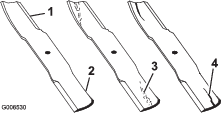
Checking for Bent Blades
-
Rotate the blades until the ends face forward and backward.
-
Measure from a level surface to the cutting edge, position A, of the blades (Figure 68).
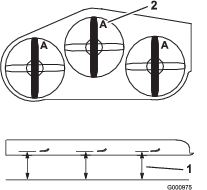
-
Rotate the opposite ends of the blades forward.
-
Measure from a level surface to the cutting edge of the blades at the same position as in step 2 above.
Note: The difference between the dimensions obtained in steps 2 and 3 must not exceed 3 mm (1/8 inch).
Note: If this dimension exceeds 3 mm (1/8 inch), replace the blade.
Warning
A blade that is bent or damaged could break apart and could critically injure you or bystanders.
-
Always replace a bent or damaged blade with a new blade.
-
Do not file or create sharp notches in the edges or surfaces of the blade.
-
Removing the Blades
Replace the blade if a blade hits a solid object, is out of balance, or is bent. For best performance and continued safety conformance of the machine, use genuine Toro replacement blades. Replacement blades made by other manufacturers may result in non-conformance with safety standards.
-
Hold the blade end using a rag or thickly padded glove.
-
Remove the blade bolt, curved washer, and blade from the spindle shaft (Figure 69).
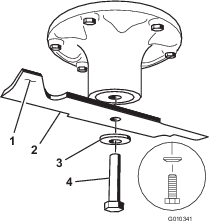
Sharpening the Blades
-
Use a file to sharpen the cutting edge at both ends of the blade (Figure 70).
Note: Maintain the original angle.
Note: The blade retains its balance if the same amount of material is removed from both cutting edges.

-
Check the balance of the blade by putting it on a blade balancer (Figure 71).
Note: If the blade stays in a horizontal position, the blade is balanced and can be used.
Note: If the blade is not balanced, file some metal off the end of the sail area only (Figure 70).

-
Repeat this procedure until the blade is balanced.
Installing the Blades
| Maintenance Service Interval | Maintenance Procedure |
|---|---|
| Yearly |
|
-
Inspect the blade bolt for damaged threads. Replace the bolt and curved washer as necessary.
-
Install the blade onto the spindle shaft (Figure 72).
Important: The curved part of the blade must be pointing upward toward the inside of the deck to ensure proper cutting.
-
Install the curved washer and blade bolt (Figure 72).
Note: The curved washer cone must be installed toward the bolt head (Figure 72).
-
Torque the blade bolt to 115 to 150 N∙m (85 to 110 ft-lb).
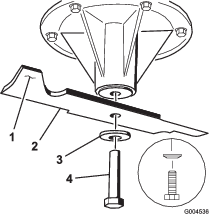
Leveling the Mower Deck
Preparing the Machine
Ensure that the mower deck is level any time you install the mower deck or when you see an uneven cut on your lawn.
Level the mower deck side to side before adjusting the front-to-rear slope.
-
Park the machine on a level surface, disengage the PTO, and engage the parking brake.
-
Shut off the engine, remove the key, and disconnect the spark-plug wires from the spark plugs.
-
Check the tire pressure of both drive tires; refer to Checking the Tire Pressure.
-
Check the mower deck for bent blades; remove and replace any bent blades; refer to Servicing the Cutting Blades.
-
Lower the mower deck to the 76 mm (3 inch) height-of-cut position.
Checking the Side-to-Side Level
-
Position the blades side to side.
-
Measure at the B and C locations from a level surface to the cutting edge of blade tips (Figure 73).
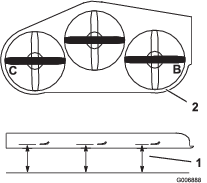
-
The difference between measurements B and C should be no more than 6 mm (1/4 inch).
Note: If it is not correct, refer to Leveling the Mower Deck.
Checking the Mower Deck Front-to-Rear Pitch
-
Adjust the tire pressure in the rear tires to the correct specifications.
-
Position 1 blade front-to-rear. Measure at A and B locations from a level surface to the cutting edge of the blade tips (Figure 74).
Note: The mower blade should be 6 mm (1/4 inch) lower in front at A than in the rear at B.
-
Rotate the blades and repeat for other blades.
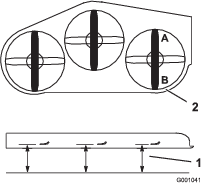
-
If the front-to-rear pitch is not correct, refer to Leveling the Mower Deck.
Leveling the Mower Deck
-
Park the machine on a level surface, disengage the PTO, and engage the parking brake.
-
Shut off the engine, remove the key, and wait for all moving parts to stop before leaving the operating position.
-
Set the height-of-cut lever to the 76 mm (3 inch) position; refer to Adjusting the Height of Cut
-
Place 2 blocks, each having a thickness of 6.6 cm (2-5/8 inches), under each side of the front edge of the deck but not under the anti-scalp roller brackets (Figure 75).
-
Place 2 blocks, each having a thickness of 7.3 cm (2-7/8 inches), under the rear edge of the cutting deck skirt, 1 on each side of the cutting deck (Figure 75).
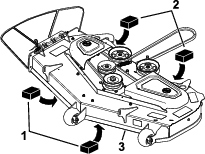
-
Loosen the adjustment bolts on all 4 corners of the deck so that the deck is sitting on all 4 blocks.
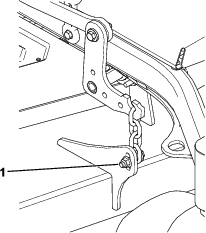
-
Ensure that the chains are taut and tighten the bolts.
-
Check the side-to-side level and the front-to-rear pitch; refer to Checking the Side-to-Side Level and Checking the Mower Deck Front-to-Rear Pitch.
Replacing the Grass Deflector
| Maintenance Service Interval | Maintenance Procedure |
|---|---|
| Before each use or daily |
|
Warning
An uncovered discharge opening could allow the machine to throw objects toward you or bystanders, resulting in serious injury. Also, contact with the blade could occur.
Never operate the machine unless you install a mulch plate, discharge deflector, or grass collection system.
-
Disengage the spring from the notch in the deflector bracket and slide the rod out of the welded deck brackets, spring, and discharge deflector (Figure 77).
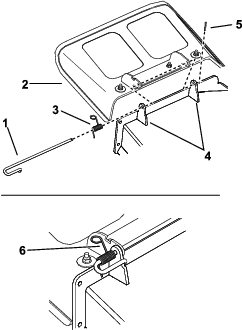
-
Remove the damaged or worn discharge deflector.
-
Position the new discharge deflector with the bracket ends between the welded brackets on the deck as shown in Figure 78.
-
Install the spring onto the straight end of the rod.
-
Position the spring on the rod as shown in Figure 78 so that the shorter spring end comes from under the rod before the bend and going over the rod as it returns from the bend.
-
Lift the loop end of the spring and place it into the notch on the deflector bracket (Figure 78).
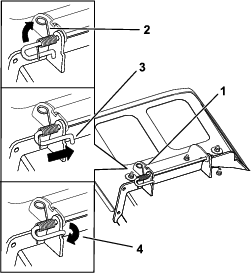
-
Secure the rod and spring assembly by twisting it so that the short end of the rod is behind the mower bracket welded to the deck (Figure 78).
Important: The grass deflector must be spring loaded in the down position. Lift the deflector up to test that it snaps to the full down position.
Cleaning
Cleaning under the Mower
| Maintenance Service Interval | Maintenance Procedure |
|---|---|
| Before each use or daily |
|
Remove the grass buildup under the mower daily.
-
Park the machine on a level surface, disengage the PTO, and engage the parking brake.
-
Shut off the engine, remove the key, and disconnect the spark-plug wires from the spark plugs.
-
Raise the front of the machine using a jack and use jack stands to support the machine.
-
Clean the machine with a rag. Do not spray the machine.
Disposing of Waste
Engine oil, batteries, hydraulic fluid, and engine coolant are pollutants to the environment. Dispose of these according to your state and local regulations.
Storage
Storage Safety
-
Always shut off the machine, remove the ignition key, wait for all moving parts to stop, and allow the machine to cool before adjusting, servicing, cleaning, or storing it.
-
Let the engine cool before storing the machine.
-
Do not store the machine or fuel near flames or drain the fuel indoors.
Cleaning and Storing the Machine
-
Park the machine on a level surface, disengage the PTO, and engage the parking brake.
-
Shut off the engine, remove the key, and wait for all moving parts to stop before leaving the operating position.
-
Remove grass clippings, dirt, and grime from the external parts of the entire machine, especially the engine and hydraulic system.
Important: You can wash the machine with mild detergent and water. Do not pressure-wash the machine. Avoid excessive use of water, especially near the control panel, engine, hydraulic pumps, and motors.
-
Check the parking brake operation; refer to Testing the Parking Brake.
-
Service the air cleaner; refer to Servicing the Air Cleaner.
-
Grease the machine; refer to Greasing the Machine.
-
Change the crankcase oil; refer to Servicing the Engine Oil.
-
Check the tire pressure; refer to Checking the Tire Pressure.
-
Charge the battery; refer to Servicing the Battery.
-
Scrape any heavy buildup of grass and dirt from the underside of the mower, then wash the machine with a garden hose.
Note: Run the machine with the blade-control switch (PTO) engaged and the engine at high idle for 2 to 5 minutes after washing.
-
Check the condition of the blades; refer to Servicing the Cutting Blades.
-
Prepare the machine for storage for over 30 days as follows:
-
Add fuel stabilizer/conditioner to fresh fuel in the tank. Follow mixing instructions from the fuel stabilizer manufacturer. Do not use an alcohol-based stabilizer (ethanol or methanol).
-
Run the engine to distribute conditioned fuel through the fuel system for 5 minutes.
-
Shut off the engine, allow it to cool, and drain the fuel tank.
-
Start the engine and run it until it shuts off.
-
Dispose of fuel properly. Recycle the fuel according to local codes.
Important: Do not store fuel containing stabilizer/conditioner longer than the duration recommended by the fuel-stabilizer manufacturer.
-
-
Remove and check the condition of the spark plug(s); refer to Servicing the Spark Plug. With the spark plug(s) removed from the engine, pour 30 ml (2 tablespoons) of engine oil into the spark plug hole. Use the starter to crank the engine and distribute the oil inside the cylinder. Install the spark plug(s). Do not install the wire on the spark plug(s).
-
Check and tighten all fasteners. Repair or replace any part that is damaged.
-
Paint all scratched or bare metal surfaces. Paint is available from your Authorized Service Dealer.
-
Store the machine in a clean, dry garage or storage area. Remove the key from the switch and keep it out of reach of children or other unauthorized users. Cover the machine to protect it and keep it clean.
Troubleshooting
| Problem | Possible Cause | Corrective Action |
|---|---|---|
| The fuel tank is showing signs of collapsing or the machine is frequently showing signs of running out of fuel. |
|
|
| The engine overheats. |
|
|
| The starter does not crank. |
|
|
| The engine does not start, starts hard, or fails to keep running. |
|
|
| The engine loses power. |
|
|
| The machine does not drive. |
|
|
| There is abnormal vibration. |
|
|
| The cutting height is uneven. |
|
|
| The blades do not rotate. |
|
|
| The mower deck idler is making noise. |
|
|
Schematics
Electrical Schematic for Machines with Standard Air Cleaner—139-2853
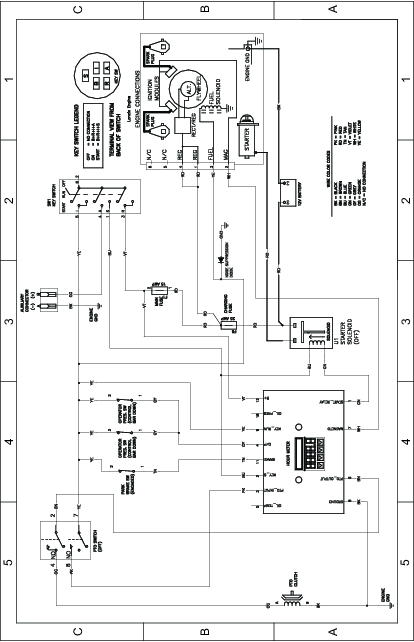
Electrical Schematic for Machines with Heavy Duty Air Cleaner—138–691
